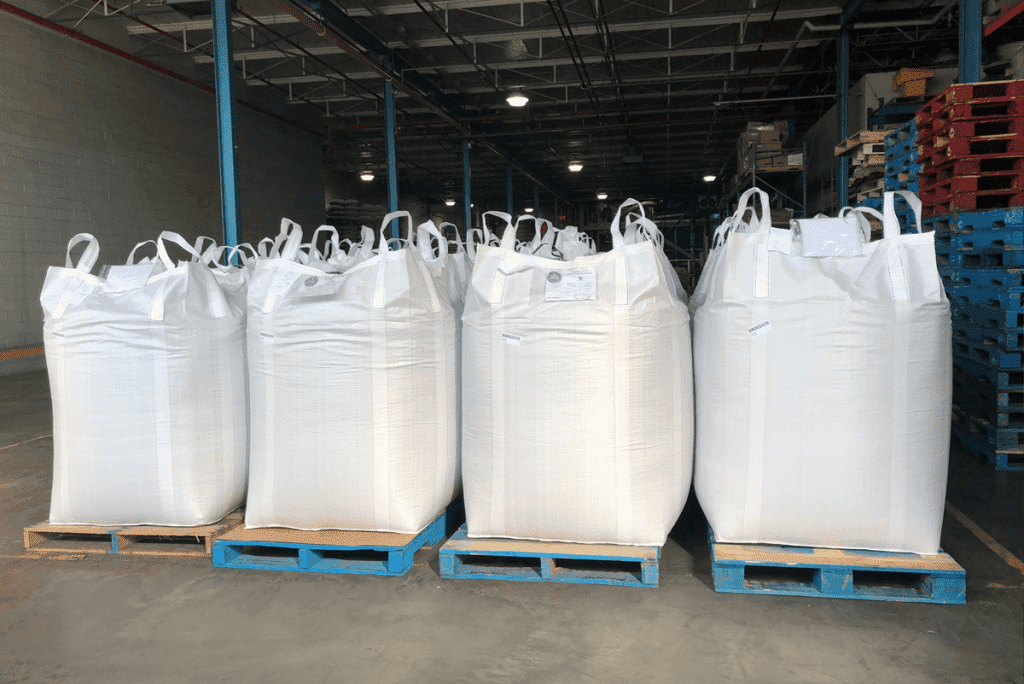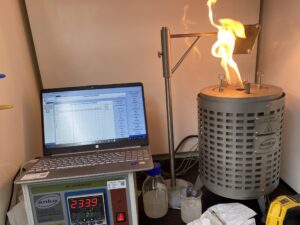We also offer
What is Flexible Intermediate Bulk Container (FIBC) Testing
Flexible Intermediate Bulk Containers (FIBCs) are widely used for storing and transporting powders and granules. Typically made from polypropylene fabric or other strong insulating materials, FIBCs can accumulate electrostatic charges during filling or emptying. If these charges discharge in a flammable atmosphere, they can ignite and cause serious hazards.
Testing Principle and Methodology
FIBC testing classifies containers as Type A, B, C, or D according to IEC 61340-4-4. The classification depends on how the FIBC prevents incendiary discharges. Testing may include:
-
Breakdown voltage measurements
-
Surface resistivity measurements
These tests are performed in two temperature and humidity-controlled conditions:
-
(23 ± 2) °C and (20 ± 5) % RH
-
(23 ± 2) °C and (60 ± 10) % RH
Applicable Standard
FIBC testing is conducted in accordance with:
-
IEC 60243-1
-
ASTM D3755-20
-
IEC 61340-4-4
Data Interpretation
-
Type A – No static protection. Made from fabric or plastic sheet without measures against static buildup. Intended for non-flammable materials only.
-
Type B – Reduces risk of propagating brush discharges but does not fully protect against incendiary discharges.
-
Type C – Conductive fabric or fabric interwoven with conductive threads. Must be grounded during filling/emptying. Prevents sparks and brush discharges by dissipating charges to earth.
-
Type D – Static protective fabric that prevents sparks and brush discharges without grounding. Suitable for flammable atmospheres.
When to Perform FIBC Testing
Testing should be carried out:
-
During product development
-
For quality control in manufacturing
-
For certification and compliance
-
During periodic inspections
-
When handling sensitive materials in transportation and storage
The goal is to ensure the FIBC design prevents incendiary discharges during its intended use.
Why Choose Prime Process Safety Center
Prime Process Safety Center is a leader in process safety testing, staffed by highly experienced laboratory professionals. Our mission is to deliver accurate, reliable, and defensible data that meets both industry and regulatory standards.
What sets us apart:
-
Expertise in FIBC electrostatic testing – Our team has extensive experience in performing precise and compliant FIBC tests.
-
Advanced testing equipment – We use state-of-the-art systems for highly sensitive and accurate measurements.
-
Strict quality control – We follow rigorous protocols to ensure consistent, repeatable results.
-
Actionable insights – Our experts interpret your data and provide recommendations tailored to your specific application or research needs.
When you work with Prime Process Safety Center, you can be confident that your FIBC testing is performed to the highest standards—helping you ensure compliance, protect your operations, and reduce risk in potentially explosive environments.
FAQ
What is an FIBC?
Answer: An FIBC, also known as a bulk bag or super sack, is a large, flexible container used for transporting and storing bulk materials such as grains, powders, chemicals, and other granular substances. It is made of flexible fabric and typically features lifting loops for handling by forklifts or cranes.
What are the Different Types of FIBCs?
Answer: FIBCs are categorized into various types based on their construction and intended use, including Type A (non-conductive), Type B (with low breakdown resistance), Type C (conductive), and Type D (anti-static or static dissipative) bags. These types differ in their electrostatic properties and safety features.
What Are the Safety Features of FIBCs?
Answer: FIBCs are designed with safety features such as anti-static properties (in Type C and Type D bags) to prevent the buildup of electrostatic charges, grounding mechanisms (in Type C bags) for dissipating charges safely, and various strength and stability features to ensure safe handling and transportation.
What Are the Load Capacities of FIBCs?
Answer: FIBC load capacities, often referred to as Safe Working Load (SWL), vary based on their design, size, and construction. Standard FIBCs can typically hold loads ranging from 500 kg to over 2,000 kg, while customized or specialized bags might have different load capacities.
What Materials Can FIBCs Safely Handle?
Answer: FIBCs are used for handling a wide range of materials, including agricultural products (grains, seeds), chemicals, minerals, pharmaceuticals, and powdered or granular substances. The suitability of an FIBC for a specific material depends on its construction, strength, and compatibility with the substance's properties. Evaluation of materials’ MIE and electrostatic features are essential to select the appropriate type of FIBC for safe handling of material.
















